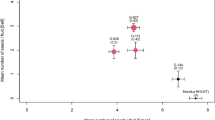Summary
Electrophoresis of 7 pollen enzymes was applied to 5 progenies from controlled crosses and one self-progeny of apple. Segregation data were examined according to three kinds of hypotheses: monogenic disomic, bigenic disomic and tetrasomic inheritance Twenty codominant alleles and a recessive null were identified. Results provided evidence of bigenic disomic inheritance in most cases: 6 pairs of homoeologous loci carrying identical homoeoalleles were revealed; only 2 enzymes exhibited a simple monogenic control. Preferential pairing between pairs of homologous chromosomes in meiosis can be postulated. These results indicated an allopolyploid origin of apple genome. Fixed heterozygosity occurred for several enzymes, which is a typical feature of allopolyploidy. Loss of duplicate gene expression can account for the monogenic control of 2 of the enzymes.
Similar content being viewed by others
References
Alston FH (1976) Practical aspects of breeding for mildew (Podosphaera leucotricha) resistance in apples. In: Proc Eucarpia Meeting Tree Fruit Breeding. PUDOC, Wageningen, pp 4–17
Cadic A (1982) Pollinisation et incompatibilité interspécifique dans le genre Berberis. Scl Fr 30:37–43
Challice JS (1981) Chemotaxonomic studies in the family Rosaceae and the evolutionary origins of the subfamily Maloideae. Preslia 53:289–304
Challice JS, Westwood MN (1973) Numerical taxonomic studies of the genus Pyrus using both chemical and botanical characters. Bot J Linn Soc 67:121–148
Chevreau E (1984) Contribution à l'étude de la génétique du Pommier: apport de l'analyse enzymatique. Thèse de Docteur Ingénieur, Orsay
Darlington CD, Moffett AA (1930) Primary and secondary chromosome balance in Pyrus. J Genet 22:129–151
Decourtye L (1967) Etude de quelques caractères à contrôle génétique simple chez le Pommier (Malus sp.) et le Poirier (Pyrus communis). Ann Amelior Plant 17:243–265
De Wet JMJ (1980) Origins of polyploids. In: Lewis WH (ed) Polyploidy: biological relevance. Plenum Press, New York, pp 3–16
Ferris DS, Whitt GS (1979) Evolution of the differential regulation of duplicates genes after polyploidization. J Mol Evol 12:267–317
Garcia-Olmedo F, Carbonero P, Aragoncillo C, Salcedo G (1977) Loss of redundant gene expression after polyploidization in plants. Experientia 34:332–333
Hutchinson ES, Hakim-Elahi A, Miller RD, Allard RW (1983) The genetics of diploidized tetraploid Avena barbata. J Hered 74:381–383
Lespinasse Y (1973) Chromosomic observations in Malus and Pyrus. In: Proc Eucarpia Fruit Sect Symp V. Canterbury, pp 75–83
Lewis EJ, Humphreys MW, Caton MP (1980) Disomic inheritance in Festuca arundinacea Schreb. Z Pflanzenzücht 84: 335–341
Li WH (1980) Rate of silencing at duplicate loci: a theoretical study and interpretation of data from tetraploid fishes. Genetics 95:237–258
Misic P, Vinterhalter D, Todorovic R (1981) The inheritance of isoperoxidases in apples. Jugosl Vocarstvo 14:43–47
Mulcahy DL (1979) The rise of the angiosperms: a genecological factor. Science 206:20–23
Quiros CF (1982) Tetrasomic segregation for multiple alleles in alfalfa. Genetics 101:117–127
Sanford JC (1983) Ploidy manipulations. In: Moore JN, Janick J (eds) Methods in fruit breeding. Purdue University Press, West Lafayette Ind, pp 100–123
Sax K (1931) The origin and relationships of the Pomoideae. J Arnold Arbor 12:3–22
Sax K (1933) The origin of the Pomoideae. J Am Soc Hortic Sci 30:147–150
Stebbins G (1950) Polyploidy and the origin of higher categories. In: Variation and evolution in plants. Columbia University Press, New York, pp 359–362
Vinterhalter DV, James DT (1982/83) The use of peroxidase polymorphism in the identification of apple scion cultivars. Sci Hortic 18:253–261
Wilson HD, Barber SC, Walters T (1983) Loss of duplicate gene expression in tetraploid Chenopodium. Biochem Syst Ecol 11:7–13
Zamir D (1983) Pollen gene expression and selection: applications in plant breeding. In: Tanksley SD, Orton TJ (eds) Isozymes in plant genetics and breeding, part A. Elsevier, Amsterdam, pp 313–330
Author information
Authors and Affiliations
Additional information
Communicated by F. Salamini
The results reported in this paper are part of a thesis by the first author for the degree of “Docteur Ingénieur”
Rights and permissions
About this article
Cite this article
Chevreau, E., Lespinasse, Y. & Gallet, M. Inheritance of pollen enzymes and polyploid origin of apple (Malus x domestica Borkh.). Theoret. Appl. Genetics 71, 268–277 (1985). https://doi.org/10.1007/BF00252066
Received:
Accepted:
Issue Date:
DOI: https://doi.org/10.1007/BF00252066




